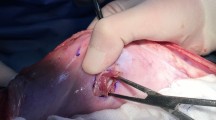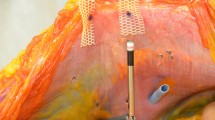Abstract
Purpose
Laparoscopic ventral and incisional hernia repair (LVIHR) has become a common procedure because of its feasibility and safety, but it is not free of complications. Acute and chronic post-operative pain and bleeding caused by traumatic fixation of the mesh are frequently prolonging the hospital stay. The aim of this study was to analyze the behavior of n-butyl-cyanoacrylate (GLUBRAN® 2) as only mesh fixation
Methods
Ten female pigs were involved in the study and were divided into two groups of five (A and B). Animals in each group underwent a laparoscopic procedure in which two meshes were placed intraperitoneally and fixed with the same synthetic glue only. Animals in group A were sacrificed after 3 weeks, and those in group B were sacrificed after 12 weeks. We studied the morphological, biomechanical, and histological characteristics of the intraperitoneal mesh–tissue interface
Results
No disruption, migration or folding was observed in any of the pigs. In group A, the mean tensile strength was 1.4 N/cm (± 0.2) while in group B, the mean tensile strength was 2.5 N/cm (± 0.8). Histological analyses, in areas where mesh was fixed using the glue, showed a chronic lymphocytic inflammatory reaction with a granulomatous component and a marked desmoplastic reaction made up of immature collagen and numerous fibroblasts acquiring myofibroblastic characteristics. In some areas corresponding to fixation, the desmoplastic reaction originated from mature lamellar bone tissue with osteocytes and osteoblasts.
Conclusion
Laparoscopic mesh fixation with only the synthetic comonomer glue GLUBRAN® 2 is feasible, effective, and safe in intraperitoneal incisional/ventral hernia repair in this animal model.





Similar content being viewed by others
References
Rosenberg J (2009) Pain, quality of life and recovery after laparoscopic ventral hernia repair. Hernia 13:13–21. https://doi.org/10.1007/s10029-008-0414-9
Langbach O (2015) Long term recurrence, pain and patient satisfaction after ventral hernia mesh repair. World J Gastrointest Surg 7(12):384. https://doi.org/10.4240/wjgs.v7.i12.384
Wassenaar E, Schoenmaeckers E (2010) Mesh-fixation method and pain and quality of life after laparoscopic ventral or incisional hernia repair: a randomized trial of three fixation techniques. Surg Endosc 24:1296–1302. https://doi.org/10.1007/s00464-009-0763-1
Reynvoet E, Deschepper E, Rogiers X, Troisi R, Berrevoet F (2014) Laparoscopic ventral hernia repair: is there an optimal mesh fixation technique? A systematic review. Langenbeck's Arch Surg 399:55–63. https://doi.org/10.1007/s00423-013-1126-x
Muysoms F, Vander Mijnsbrugge G, Pletinckx P et al (2013) Randomized clinical trial of mesh fixation with “double crown” versus “sutures and tackers” in laparoscopic ventral hernia repair. Hernia 17(5):603–612. https://doi.org/10.1007/s10029-013-1084-9
Antoniou SA, Ph D, Ko G et al (2015) Meta-analysis of randomized trials comparing nonpenetrating vs mechanical mesh fixation in laparoscopic inguinal hernia repair. Am J Surg. https://doi.org/10.1016/j.amjsurg.2015.06.008
Shah NS, Fullwood C (2014) Mesh fixation at laparoscopic inguinal hernia repair: a meta-analysis comparing tissue glue and tack fixation. World J Surg 38:2558–2570. https://doi.org/10.1007/s00268-014-2547-6
Fortelny RH, Petter-Puchner AH, Glaser KS, Redl H (2012) Use of fibrin sealant (Tisseel/Tissucol) in hernia repair: a systematic review. Surg Endosc Other Interv Tech 26(7):1803–1812. https://doi.org/10.1007/s00464-012-2156-0
Ladurner R, Drosse I, Bu D et al (2011) Cyanoacrylate glue for intra-abdominal mesh fixation of polypropylene-polyvinylidene fluoride meshes in a rabbit model. J Surg Res 162:157–162. https://doi.org/10.1016/j.jss.2009.11.710
Losi P, Burchielli S, Vet MD et al (2010) Cyanoacrylate surgical glue as an alternative to suture threads for mesh fixation in hernia repair. J Surg Res 6:6–11. https://doi.org/10.1016/j.jss.2010.05.003
Reynvoet E, Van Cleven S, Van Overbeke I et al (2015) The use of cyanoacrylate sealant as simple mesh fixation in laparoscopic ventral hernia repair: a large animal evaluation. Hernia 19:661–670. https://doi.org/10.1007/s10029-015-1347-8
Shen Y-M, Liu Y-T, Chen J, Sun L (2017) Efficacy and safety of NBCA (n-butyl-2-cyanoacrylate) medical adhesive for patch fixation in totally extraperitoneal prosthesis (TEP): a prospective, randomized, controlled trial. Eur Rev Med Pharmacol Sci 21(4):680–686. https://doi.org/10.1007/s10029-016-1482-x
Schwab BR (2006) Less chronic pain following mesh fixation using a fibrin sealant in TEP inguinal hernia repair. Hernia 10:272–277. https://doi.org/10.1007/s10029-006-0080-8
Burza A, Avantifiori R, Curinga R, Santini E, Delle Site PSF (2014) Comparison between two different mesh fixation methods in laparoscopic inguinal hernia repair: tacker vs synthetic cyanoacrylate glue. Minerva Chir 69(6):321–329
Rosenberg J (2008) Laparoscopic intraperitoneal mesh fixation with fibrin sealant (Tisseel®) vs. titanium tacks: a randomised controlled experimental study in pigs. Hernia 12:483–491. https://doi.org/10.1007/s10029-008-0375-z
Eriksen JR, Bisgaard T, Assaadzadeh S, Jorgensen LN, Rosenberg J (2009) Randomized clinical trial of fibrin sealant versus titanium tacks for mesh fixation in laparoscopic umbilical hernia repair. Br J Surg 98:1537–1545. https://doi.org/10.1002/bjs.7646
Stefano O, Giovanni C, Luca S, Claudio P, Giuseppe V, Enrico C (2010) Laparoscopic incisional hernia repair with fibrin glue in select patients. JSLS 14:240–245. https://doi.org/10.4293/108680810X12785289144359
Pascual G, Rodríguez M, Pérez-köhler B et al (2017) Host tissue response by the expression of collagen to cyanoacrylate adhesives used in implant fixation for abdominal hernia repair. J Mater Sci Mater Med. https://doi.org/10.1007/s10856-017-5869-8
Zinther NB, Wara P, Friis-Andersen H (2010) Intraperitoneal onlay mesh: an experimental study of adhesion formation in a sheep model. Hernia 14(3):283–289. https://doi.org/10.1007/s10029-009-0622-y
Gungor B, Malazgirt Z, Topgül K, Gök A, Bilgin M, Yürüker S (2010) Comparative evaluation of adhesions to intraperitoneally placed fixation materials: a laparoscopic study in rats. Indian J Surg 72(6):475–480. https://doi.org/10.1007/s12262-010-0168-3
Clarke T, Katkhouda N, Mason RJ (2011) Fibrin glue for intraperitoneal laparoscopic mesh fixation: a comparative study in a swine model. Surg Endosc 25:737–748. https://doi.org/10.1007/s00464-010-1244-2
Eriksen JR, Bisgaard T, Assaadzadeh S, Jorgensen LN, Rosenberg J (2013) Fibrin sealant for mesh fixation in laparoscopic umbilical hernia repair: 1-year results of a randomized controlled double-blinded study. Hernia 17:511–514. https://doi.org/10.1007/s10029-013-1101-z
Jenkins ED, Melman L, Deeken CR, Greco SC, Frisella MM, Matthews BD (2011) Biomechanical and histologic evaluation of fenestrated and nonfenestrated biologic mesh in a porcine model of ventral hernia repair. J Am Coll Surg 212(3):327–339. https://doi.org/10.1016/J.JAMCOLLSURG.2010.12.006
Schug-pass C, Lippert H (2010) Mesh fixation with fibrin glue (Tissucol/Tisseel®) in hernia repair dependent on the mesh structure—is there an optimum fibrin—mesh combination?—investigations on a biomechanical model. Langenbeck's Arch Surg 395:569–574. https://doi.org/10.1007/s00423-009-0466-z
Reynvoet E, Berrevoet F, De Somer F, Troisi R (2012) Tensile strength testing for resorbable mesh fixation systems in laparoscopic ventral hernia repair. Surg Endosc 26:2513–2520. https://doi.org/10.1007/s00464-012-2224-5
Roland L (2008) Tissue attachment strength and adhesion formation of intraabdominal fixed meshes with cyanoacrylat glues. Eur J Med Res 13:185
Rieder E, Stoiber M, Scheikl V et al (2010) Mesh fixation in laparoscopic incisional hernia repair: glue fixation provides attachment strength similar to absorbable tacks but differs substantially in different meshes. ACS 212(1):80–86. https://doi.org/10.1016/j.jamcollsurg.2010.08.015
Agarwal A, Breiman RS, Coakley FV (2004) Peritoneal calcification : causes and distinguishing features on CT. Am J Roentgenol 182:441–445
Shen J, Nair A, Saxena R, Zhang CC, Borrelli J Jr, Tang L (2014) Tissue engineering bone using autologous progenitor cells in the peritoneum. PLoS ONE 9(3):1–7. https://doi.org/10.1371/journal.pone.0093514
Paper O (2012) Estrogen and its receptor enhance mechanobiological effects in compressed bone mesenchymal stem cells. Cells Tissues Organs 195:400–413. https://doi.org/10.1159/000328003
Acknowledgements
We thank Immunohistochemistry Unit, from IRBLleida for Immunohistochemical support. Also we thank Prof. Alessandro Poli of the Veterinarian Science department from Pisa University (Italy). A special acknowledgment to CREBA (Centre de Recerca Biomèdica Avançada) center and their excellent team for facilitating the operating rooms and taking care of the animals during this study
Funding
This study was funded by GEM S.R.L. (LU) Italy.
Author information
Authors and Affiliations
Corresponding author
Ethics declarations
Conflict of interest
Author RV, author CM, author CG, author YM, author MN, author FV, and author JO declare that they have no conflict of interest.
Ethical approval
All applicable international, national, and institutional guidelines for the care and use of animals were followed: Resolution No .9769 of directorate general for environmental policy, Generalitat de Catalunya, Spain.
Human and animal rights
This study does not contain any studies directly involving human participants .
Informed consent
For this type of study formal consent was not necessary.
Additional information
Publisher's Note
Springer Nature remains neutral with regard to jurisdictional claims in published maps and institutional affiliations.
Rights and permissions
About this article
Cite this article
Villalobos, R.N., Mias, M.C., Gas, C. et al. Atraumatic laparoscopic intraperitoneal mesh fixation using a new laparoscopic device: an animal experimental study. Hernia 23, 1123–1132 (2019). https://doi.org/10.1007/s10029-019-02008-5
Received:
Accepted:
Published:
Issue Date:
DOI: https://doi.org/10.1007/s10029-019-02008-5




